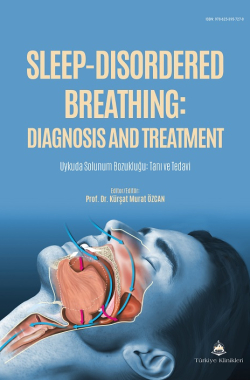SCORING OF THE RESPIRATORY EVENTS
Ayşe Seçil Kayalı Dinç
Ankara Bilkent City Hospital, Department of Otorhinolaryngology, Ankara, Türkiye
Kayalı Dinç AS. Scoring of the Respiratory Events. In: Özcan KM, editor. Sleep-Disordered Breathing: Diagnosis and Treatment. 1st ed. Ankara: Türkiye Klinikleri; 2025. p.77-84.
ABSTRACT
Scoring polysomnography correctly in the light of current guidelines and interpretation of the results appropriately is the cornerstone in sleep medicine. In case of obstructive sleep apnea, scoring the respiratory events during sleep is utmost importance for diagnosis and treatment. This section aims to address the scoring of the sleep related respiratory events in the light of current information based on the American Academy of Sleep Medicine (AASM) 2023 guidelines. Broadly speaking, respiratory disorders during sleep are characterized by the complete or partial cessation of breathing for at least 10 seconds, and include obstructive apnea, central apnea, mixed apnea, hypopnea, Cheyne-Stokes respiration, and respiratory effort-related arousal. In apneas, respiratory amplitude must decrease to at least 90% of normal breathing or cease completely. The severity of sleep apnea disorder is determined taking the number and type of sleeprelated respiratory events into account, and the treatment options are discussed with the patient accordingly. The definitions, scoring criteria and clinical significance of respiratory events have been put forward in the AASM guideline in detail. Apnea-Hypopnea Index has been defined as the number of the respiratory events per hour during sleep. Severity classifications of obstructive sleep apnea disorder based on the Apnea-Hypopnea Index are different in adult and pediatric populations, and have been comparatively examined this chapter. In adults, an Apnea-Hypopnea Index of 5-15 is considered mild, 15-30 is moderate, and over 30 is classified as severe. However, in children, an Apnea-Hypopnea Index of 1-5 is mild, 5-10 is moderate, and over 10 is considered severe. Apnea-Hypopnea Index is not only essential for diagnosis of sleepdisordered breathing, but also serves as an important indicator in determining disease severity, making treatment decisions, and for long-term patient monitoring. It has also been shown that there is a strong relationship between Apnea-Hypopnea Index and possible systemic effects of obstructive sleep apnea such as cardiovascular diseases, insulin resistance, and neurocognitive disorders including stroke. In conclusion, accurate scoring of sleep-related respiratory events is indispensable for the effective management and follow up of sleep related breathing disorders. Mastery of current guidelines, along with a flexible and individualized approach in light of evolving scientific data, is one of the most important requirements of sleep medicine.
Keywords: Apnea; Sleep apnea syndromes; Cheyne-stokes respiration; Sleep arousal disorders
Kaynak Göster
Referanslar
- Senaratna CV, Perret JL, Lodge CJ, Lowe AJ, Campbell BE, Matheson MC, Hamilton GS, Dharmage SC. Prevalence of obstructive sleep apnea in the general population: A systematic review. Sleep Med Rev. 2017;34:70-81. [Crossref] [PubMed]
- Peppard PE, Young T, Barnet JH, Palta M, Hagen EW, Hla KM. Increased prevalence of sleep-disordered breathing in adults. Am J Epidemiol. 2013;177(9):1006-14. [Crossref] [PubMed] [PMC]
- Punjabi NM. The epidemiology of adult obstructive sleep apnea. Proc Am Thorac Soc. 2008;5(2):136-43. [Crossref] [PubMed]
- American Academy of Sleep Medicine. The AASM Manual for the Scoring of Sleep and Associated Events: Rules, Terminology and Technical Specifications (Version 2.6). Darien, IL: American Academy of Sleep Medicine. 2023. [Crossref]
- Marcus CL, Brooks LJ, Draper KA, Gozal D, Halbower AC, Jones J, Schechter MS, Ward SD, Sheldon SH, Shiffman RN, Lehmann C, Spruyt K; American Academy of Pediatrics. Diagnosis and management of childhood obstructive sleep apnea syndrome. Pediatrics. 2012;130(3):e714-55. [Crossref] [PubMed]
- Marin JM, Carrizo SJ, Vicente E, Agusti AG. Longterm cardiovascular outcomes in men with obstructive sleep apnoea-hypopnoea with or without treatment with continuous positive airway pressure: an observational study. Lancet. 2005;365(9464):1046-53. [Crossref] [PubMed]
- Yaouhi K, Bertran F, Clochon P, Mézenge F, Denise P, Foret J, Eustache F, Desgranges B. A combined neuropsychological and brain imaging study of obstructive sleep apnea. J Sleep Res. 2009;18(1):36-48. [Crossref] [PubMed]
- Zhang LQ, Yao WZ, Wang YZ, Ren B, Lin YP. [Relationship between obstructive sleep apnea/hypopnea syndrome and insulin resistance]. Zhonghua Nei Ke Za Zhi. 2006;45(3):184-7. Chinese. [Crossref] [PubMed]
- Reutrakul S, Mokhlesi B. Obstructive Sleep Apnea and Diabetes: A State of the Art Review. Chest. 2017;152(5):10701086. [Crossref] [PubMed] [PMC]
- Cross N, Lampit A, Pye J, Grunstein RR, Marshall N, Naismith SL. Is Obstructive Sleep Apnoea Re-lated to Neuropsychological Function in Healthy Older Adults? A Systematic Review and Meta-Analysis. Neuropsychol Rev. 2017;27(4):389-402. [Crossref] [PubMed]

